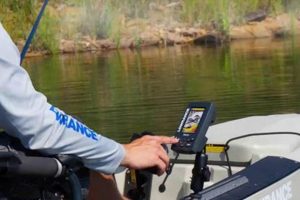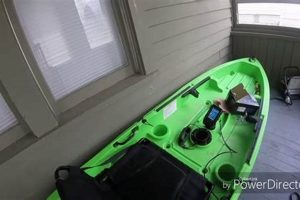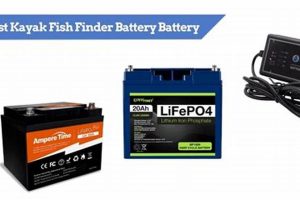A high-quality, budget-friendly sonar device designed for kayak fishing allows anglers to locate fish, map underwater structures, and understand bottom composition in shallow or deep water. This technology offers a significant advantage, enabling more efficient and successful fishing trips. For example, an angler might utilize such a device to identify a drop-off where fish congregate or to distinguish between a rocky bottom and a weedy area.
Historically, kayak anglers relied heavily on intuition and experience to find productive fishing spots. Affordable sonar technology has revolutionized the sport, making it accessible to a broader range of anglers and increasing the likelihood of a successful catch. This technology significantly enhances situational awareness on the water, contributing to both safety and enjoyment of the fishing experience.
The following sections will delve into key features to consider when selecting a suitable sonar device for kayak fishing, discuss popular models within a specific price range, and offer guidance on installation and operation.
Tips for Selecting a Kayak Fish Finder
Choosing a suitable sonar device for kayak fishing requires careful consideration of several factors. The following tips offer guidance for selecting a device that meets specific needs and budget constraints.
Tip 1: Transducer Type: Consider the kayak’s hull material and the fishing environment. Transom-mount transducers are easy to install but may interfere with paddling. In-hull transducers offer better performance in rough water but require more complex installation. Consider a portable, floating transducer for kayaks with limited mounting options.
Tip 2: Display Size and Resolution: A larger, higher-resolution display offers better clarity and detail, especially in bright sunlight. However, larger displays consume more power. Balance screen size with battery life and available mounting space.
Tip 3: Sonar Frequency: Higher frequencies (e.g., 200 kHz) provide detailed images of the bottom and fish in shallower water. Lower frequencies (e.g., 83 kHz) penetrate deeper water but offer less detail. Dual-frequency transducers offer versatility.
Tip 4: GPS and Mapping: GPS functionality allows anglers to mark waypoints, track their location, and navigate to productive fishing spots. Mapping features provide detailed charts of underwater structures and contours.
Tip 5: Power Consumption: Consider battery life and power management. Choose a device with low power consumption or invest in a dedicated battery for the fish finder.
Tip 6: Ease of Use: Opt for a user-friendly interface with intuitive controls and menus. This allows anglers to focus on fishing rather than struggling with complicated technology.
Tip 7: Durability and Waterproofing: Kayak fishing exposes electronics to harsh conditions. Choose a rugged, waterproof device built to withstand the elements.
By considering these factors, anglers can select a sonar device that significantly enhances their kayak fishing experience. A well-chosen device provides valuable underwater intelligence, leading to increased fishing success.
This information provides a foundation for informed decision-making. The subsequent section will explore specific product recommendations.
1. Display Clarity
Display clarity represents a critical factor when selecting a budget-friendly sonar device for kayak fishing. Sunlight glare on the water surface can render a low-quality display unreadable, negating the benefits of the technology. A clear, bright display with sufficient resolution ensures crucial informationfish locations, depth readings, bottom contoursremains visible even in challenging lighting conditions. For example, distinguishing between a school of baitfish and a larger game fish requires a display capable of rendering subtle differences in sonar returns. Investing in a device with superior display clarity within a budget constraint directly impacts fishing success and overall user experience.
Several factors contribute to display clarity. Pixel density, measured in pixels per inch (PPI), determines the sharpness of the image. Higher PPI values generally correlate with better image quality. Display brightness, often measured in nits or candelas per square meter (cd/m), affects visibility in bright sunlight. Higher brightness ratings improve performance under direct sunlight. Color displays offer enhanced differentiation between various sonar returns and map features, but grayscale displays often perform better in direct sunlight due to higher inherent contrast. Choosing a suitable display type involves balancing these factors based on individual needs and fishing conditions.
Prioritizing display clarity within a limited budget may require compromises in other areas, such as advanced features or processing power. However, the ability to clearly interpret the information presented by the sonar device remains paramount for effective kayak fishing. This clarity enables informed decisions about lure selection, retrieval techniques, and fishing location adjustments, ultimately maximizing the potential for a successful outing. The trade-off between display quality and other features deserves careful consideration based on individual fishing styles and priorities.
2. Transducer Suitability
Transducer suitability represents a critical factor influencing the effectiveness of a budget-conscious sonar device for kayak fishing. Optimal sonar performance hinges on selecting a transducer compatible with the kayak’s hull design and the intended fishing environment. An incompatible transducer can result in poor signal quality, inaccurate readings, and diminished functionality, thereby undermining the investment in a fish finder.
- Hull Material and Design
Kayak hull materials and designs vary significantly, influencing transducer selection. For example, a smooth, rigid hull made of fiberglass or rotomolded plastic readily accommodates transom-mount or in-hull transducers. Inflatable kayaks, due to their flexible nature, present challenges for traditional transducer installations and often benefit from portable or floating transducer options. Choosing a transducer compatible with the kayak’s specific construction ensures optimal signal transmission and reception, maximizing the fish finder’s performance.
- Fishing Environment
The fishing environment plays a pivotal role in transducer selection. Shallow freshwater environments often benefit from higher-frequency transducers, providing detailed images of the bottom and fish in shallow depths. In contrast, deeper saltwater environments may require lower-frequency transducers capable of penetrating deeper water columns, albeit with some sacrifice in detail. Understanding the target fishing environment informs transducer selection, optimizing sonar performance for specific depth ranges and water conditions.
- Transducer Mounting Options
Available transducer mounting options influence practicality and performance. Transom-mount transducers offer easy installation but may interfere with paddling or create drag. In-hull transducers provide streamlined performance but necessitate more complex installations. Portable transducers offer flexibility for use on multiple kayaks or for anglers frequently changing locations. Consider mounting options concerning kayak design and fishing style to ensure optimal transducer placement and ease of use.
- Budget Constraints
Budget considerations impact transducer selection. While advanced transducers with CHIRP technology or multiple frequencies offer enhanced performance, they often come at a premium. Entry-level transducers provide adequate functionality for many kayak anglers within a limited budget. Balancing performance requirements with budgetary constraints necessitates careful evaluation of transducer options to maximize sonar effectiveness without exceeding financial limitations. A cost-effective transducer compatible with the kayak and fishing environment still provides valuable underwater intelligence.
Careful consideration of transducer suitability in relation to the kayak’s structure, fishing environment, and budget ensures optimal fish finder performance. A well-chosen transducer maximizes the return on investment in a budget-friendly sonar device, providing valuable insights into underwater structure and fish location, ultimately enhancing fishing success.
3. Sonar Functionality
Sonar functionality represents a pivotal aspect when evaluating budget-friendly fish finders for kayaks. Effective sonar interpretation directly influences angling success. Distinguishing between bottom structure, vegetation, and fish requires a clear understanding of sonar readings. Traditional 2D sonar portrays a cross-sectional view of the water column beneath the kayak. This view allows anglers to identify depth changes, locate submerged objects, and detect fish. Down-imaging sonar provides a more detailed, photographic-like view of the bottom, enabling differentiation between hard and soft bottoms, identifying submerged vegetation, and pinpointing fish holding close to structure. CHIRP sonar, while often exceeding the $200 budget, offers superior target separation and clarity, particularly in deeper water or challenging conditions. Within the budget constraint, prioritizing clear 2D sonar functionality remains crucial for effective fish finding and bottom mapping.
Consider a scenario where an angler seeks to locate fish near a submerged drop-off. A fish finder with basic 2D sonar allows the angler to identify the drop-off and observe fish symbols or arches indicating fish presence near the structure. Down-imaging, if available within the budget, further enhances the angler’s understanding of the drop-off’s composition, revealing whether it consists of rocks, gravel, or vegetation. This granular detail informs lure selection and presentation. For example, identifying a rocky bottom might suggest using a bottom-bouncing jig, whereas a weedy bottom might necessitate a weedless presentation. Understanding sonar returns empowers anglers to make informed decisions about fishing strategy, maximizing their chances of success.
Prioritizing effective sonar interpretation within a limited budget ultimately enhances the value of the fish finder. While advanced features like CHIRP sonar offer performance advantages, mastering the interpretation of basic 2D sonar data provides a significant advantage in locating fish and understanding underwater terrain. This fundamental skill, coupled with careful consideration of transducer selection and display clarity, maximizes the utility of a budget-friendly fish finder for kayak anglers. The ability to effectively leverage sonar information translates directly into improved fishing success, proving the importance of sonar functionality within the broader context of kayak fishing equipment selection.
4. GPS Capabilities
GPS functionality represents a significant value proposition within the context of budget-conscious kayak fishing electronics. While not strictly essential for sonar operation, GPS integration enhances situational awareness, navigation efficiency, and the ability to consistently locate productive fishing areas. For kayak anglers operating within a defined budget, carefully evaluating the trade-offs between GPS capabilities and other fish finder features becomes paramount.
- Waypoint Marking
Waypoint marking allows anglers to save specific locations of interest, such as underwater structure, vegetation beds, or areas of concentrated fish activity. This feature simplifies navigation back to productive spots, eliminating the need to rely solely on memory or visual landmarks. For example, an angler locating a submerged reef or a drop-off teeming with fish can mark the location with a waypoint, facilitating return trips to the same productive area.
- Navigation and Route Planning
GPS-enabled fish finders often include basic navigation features, allowing anglers to plan routes, follow pre-determined tracks, and navigate to specific coordinates. This functionality proves especially valuable in unfamiliar waters or during low-visibility conditions. Kayak anglers can utilize GPS data to navigate safely back to their launch point, even in fog or darkness. This navigational aid enhances safety and extends the range of comfortable kayak fishing excursions.
- Speed and Distance Tracking
GPS technology enables accurate speed and distance tracking, providing valuable data for anglers seeking to optimize trolling speeds or estimate travel times. Understanding boat speed relative to water currents assists in presenting lures at the optimal speed for specific target species. Knowing distances traveled contributes to efficient time management on the water, maximizing fishing time.
- Mapping Integration
Some budget-friendly fish finders offer basic mapping capabilities, displaying rudimentary charts or allowing users to upload compatible map data. While detailed cartography often requires higher-end units, even basic mapping functionality within a budget constraint provides valuable context regarding underwater terrain and navigable channels. Understanding bottom contours contributes to informed decisions regarding fishing location selection.
Integrating GPS capabilities within a budget-friendly fish finder enhances the overall value of the device. While advanced GPS features like real-time mapping or sophisticated route planning may fall outside the $200 price range, basic waypoint marking, navigation, and speed tracking contribute significantly to improved fishing efficiency and safety. Careful consideration of these features within a budget constraint allows kayak anglers to maximize their investment, gaining valuable situational awareness and navigational tools without compromising essential sonar functionality.
5. Power Management
Power management constitutes a critical consideration when selecting a fish finder for kayak use, particularly within a budget of $200. Kayak anglers often rely on limited battery capacity, necessitating efficient power consumption to ensure extended operation on the water. Fish finders consume power at varying rates depending on screen brightness, sonar frequency, and utilization of additional features like GPS. Selecting a unit that balances performance with power efficiency becomes paramount for maximizing fishing time without frequent battery replacements or recharging. For example, opting for a lower screen brightness setting or utilizing power-saving modes can significantly extend battery life. Conversely, continuous use of high-frequency sonar or GPS navigation will deplete battery reserves more rapidly. Understanding the interplay between these factors allows for informed decisions regarding power consumption and battery management strategies.
Several practical strategies can optimize power management for kayak fish finders. Utilizing a dedicated battery specifically for the fish finder isolates its power consumption from other onboard electronics, preventing unexpected power drain on essential systems like navigation lights or communication devices. Employing a portable power bank provides a readily available backup power source, extending operational time in situations of high power demand or prolonged fishing trips. Minimizing screen brightness when detailed sonar information is not crucial reduces power consumption without significantly impacting functionality. Disabling GPS when navigating familiar waters or relying on alternative navigation methods conserves battery power for essential sonar operation. Understanding the power consumption characteristics of specific fish finder models empowers informed decision-making, allowing anglers to choose a unit that aligns with their power management needs and fishing style.
Effective power management directly impacts the overall utility and enjoyment of a kayak fishing experience. Running out of battery power prematurely curtails fishing time and potentially compromises safety, especially in remote locations or during low-visibility conditions. Careful consideration of power consumption characteristics during the fish finder selection process, coupled with the implementation of practical power-saving strategies, ensures uninterrupted operation and maximizes the value of the device. Within a $200 budget, balancing performance features with power efficiency becomes a critical factor in choosing a fish finder that meets both angling needs and power management constraints. A power-conscious approach enhances the overall kayak fishing experience, promoting both safety and enjoyment on the water.
Frequently Asked Questions
This section addresses common inquiries regarding the selection and utilization of budget-friendly sonar devices designed for kayak fishing.
Question 1: What transducer type is most suitable for an inflatable kayak?
Inflatable kayaks often benefit from portable or floating transducers due to the challenges associated with mounting traditional transducers on flexible hulls. Suction cup mounts or specialized inflatable kayak transducer mounts offer practical solutions.
Question 2: Does GPS functionality significantly impact battery life?
Continuous GPS usage does consume battery power. Disabling GPS when navigating familiar waters or relying on alternative navigation methods can extend battery life. Power-saving modes also minimize GPS power consumption.
Question 3: Is CHIRP sonar technology available within a $200 budget?
While some budget-friendly units may advertise CHIRP functionality, true broadband CHIRP sonar typically exceeds this price point. Focus on clear 2D sonar performance within a limited budget.
Question 4: How does screen size affect usability on a kayak?
Larger screens enhance visibility but may require more mounting space and consume additional power. Balance screen size with kayak layout and power management considerations. A compact display may suffice for basic sonar interpretation.
Question 5: Can a fish finder help locate specific fish species?
While fish finders do not identify species directly, sonar data can suggest fish size and location relative to structure. Interpreting sonar returns in conjunction with knowledge of local species and habitat preferences can improve targeting specific fish.
Question 6: What maintenance is required for a kayak fish finder?
Regularly rinse the transducer and display with fresh water after each use to remove salt, dirt, and debris. Protect the display from direct sunlight when not in use. Store the unit in a dry location during the off-season.
Careful consideration of these frequently asked questions enhances understanding of the key factors influencing fish finder selection and utilization within a budget constraint. Prioritizing essential features, optimizing power management strategies, and understanding sonar interpretation principles contribute significantly to successful kayak fishing experiences.
The subsequent section provides concluding thoughts on equipping a kayak with budget-conscious fish finding technology.
Conclusion
Equipping a kayak with a high-quality yet budget-friendly fish finder significantly enhances angling opportunities. Careful consideration of factors such as transducer suitability, display clarity, sonar functionality, GPS capabilities, and power management ensures optimal performance within a defined budget. Prioritizing essential features based on individual fishing styles and target environments maximizes the return on investment. Understanding sonar interpretation principles and implementing effective power management strategies further amplify the benefits of this technology.
Technological advancements continue to drive innovation in fish finding equipment, offering increasingly sophisticated features at accessible price points. Continued exploration of available options empowers anglers to make informed decisions, optimizing their kayak fishing experience through strategic equipment selection. Informed decision-making regarding fish finder acquisition contributes directly to enhanced angling success and enjoyment on the water.






